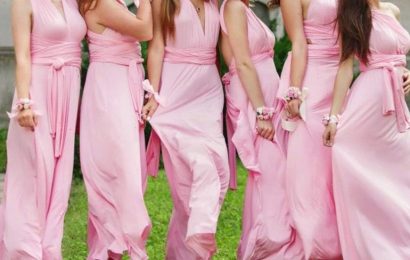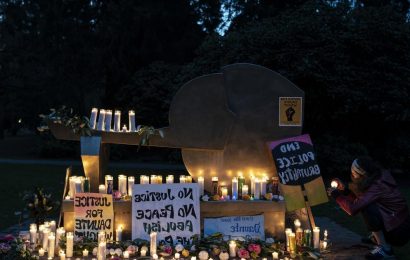TCM and HBO Max’s new series “Follow the Thread” brings costume designers and fashion designers together as it examines the relationship between fashion and costume.
Inspired by the Met’s Metropolitan Museum of Art Costume Institute’s exhibition, “In America: An Anthology of Fashion,” the series include designers Sandy Powell, Mark Bridges, Isis Mussenden and Deborah Nadoolman Landis as the world of costume design and fashion design come together. The limited series covers a spectrum of films from 1954’s “Sabrina” to 1957’s “Funny Face” to “Annie Hall” (1977) through to “Crazy Rich Asians” showing how film influences culture and impact fashion.
Speaking with Variety, Powell, Bridges, Mussenden and Nadoolman Landis discuss what drew them to the series, the biggest misconception about costume design and share their favorite transformations.
What made you say yes to this when TCM approached you about the series?
Deborah Nadoolman Landis: I was a little ambivalent. While I loved the title, the truth about costume design is that it should disappear into the tapestry of the narrative. The word ‘thread’ means a lot to me, but it was the subtitle that shook me up a little bit, which was about fashion and film.
My name is not sewn into the clothes and that’s a big issue for all costume designers. I don’t have a label, I don’t have a brand and I can’t sell the licensing for sheets and towels. I work for hire. I love fashion, and I didn’t want to add to the confusion between our production processes. So, that was the reason for my ambivalence.
Isis Mussenden: They had called me and talked about fashion and costume. I felt like there was a little misguided idea of what they were how they interacted with and how we look at fashion from a costume designer’s point of view. My entree into this project was saying, ‘Let’s dig a little deeper because there are other things that the public doesn’t know about the difference, the interaction and the way we influence one another. Even my father used to say, “My daughter’s a fashion designer.”
Sandy Powell: The first appeal was that TCM is my favorite channel in the U.S. When I used to go to the USA and stay in hotels, I’d have to make sure that they had TCM because we don’t get it here [in the U.K]. I love that you can put it on at any time of day and find something really good to watch. The other thing about TCM is that whenever you’re on a film with Martin Scorsese, he always has it on in the background in his trailer. So, I thought, ‘Yes, I’ll do this.’
Mark Bridges: I love TCM. It’s really the only station that’s on at my house. I think everybody knows that I’m a real film nerd, and costume design was included in it. It was this combination of everything I loved.
What’s the biggest misconception people have about costume design?
Nadoolman Landis: Costume design is not about the clothes, it is about the performance. Clothing is the outward expression of who we are inside. When they’re making films, filmmakers want us to believe that we are not looking at Margot Robbie anymore. We want to give her a chance to be somebody else.
Mussenden: Costume designers are storytellers. We are telling the story of specific characters, and our job is threefold. One is to further the narrative visually through costume. Another is to aid the actor in their performance, to help them feel the characters to help them become that other person. And this is our sweet spot that we love so much when we’re in our fitting room when the actor, say Julia Roberts walks in, 20 minutes later, she is Martha (“Gaslight”)or Erin Brockovich. She’s become somebody else, and that’s done through hair, makeup and costumes. It usually starts with costume because that’s where the transition starts. It’s a group effort to help aid that actor to feel that character.
We approach the design through the actor’s eye, and then we have to approach it through the 75 extras that act in that one place. Then we have to put it in a place, which is the set. We have to make sure visually it works. There are a lot of variables to consider. Is it outside? Inside? At night?
We are more couture, not like in the runway sense, but that each individual has those costumes tailored for and dyed for them. A hemline is shifted, or a neckline.
Powell: Our job is to just make people look nice and to make people look good in clothes as opposed to developing characters and helping bring characters to life and making them believable to the audience. It’s not about making people look nice.
Costume design is absolutely not fashion design. One of my pet hates is when we get called “wardrobe.” For us Brits, a wardrobe is a piece of furniture, when you refer to “wardrobe” on set, I hate that because it’s not about that. Costuming is about clothing. It’s about using clothes to help tell a story. Fashion is about designing clothes for anonymous bodies without feelings.
Bridges: People don’t realize how much of a part of the actor’s performance we are. I think they feel like it’s all surface, and it doesn’t go any deeper than that. But we are trying to bring to light the fact that we are part of that inner life of the actor and the character.
An episode talks about transformations — what are your favorites, ones that either you’ve worked on or one that you’ve seen that has stuck with you?
Nadoolman Landis: Christian Bale in everything. Also Charlize Theron in “Monster.” She is willing to do whatever it takes. Here’s a woman who is a bombshell, like Margot Robbie, and they’re willing to be everything including not so attractive.
Mussenden: It has to be Tilda Swinton in “The Lion, The Witch and The Wardrobe.” I was lucky enough to have a beautiful canvas in Tilda Swinton as the white ice queen, this half witch, half giant.
I never wanted it to feel like she had a closet, and I needed to get that illusion of height. so, I had the ice crown coming out of her head organically and melting as she lost her power.
Her dress moved in volume and tone in conjunction with what was happening with her power. We created the illusion of height in the lace through a smaller geometry of the pattern at the top and larger at the bottom. My director gave me that first shot right from the bottom straight up to the up to her head and to make her look like she was eight feet high. It was a great puzzle, and she has this amazing ability to morph.
Powell: It has to be Bette Davis in “Now Voyager.” It’s a classic isn’t it? There’s always “Cinderella,” and the rags to riches transformation.
Bridges: I love the transformation in “Now Voyager.” That’s a great transformation. I love “Pocketful of Miracles” by Frank Capra where Apple Annie is changed into this fake countess. I love “Miss Congeniality.” I love anything where the outer is pretending to be something that the inner isn’t.
Source: Read Full Article






